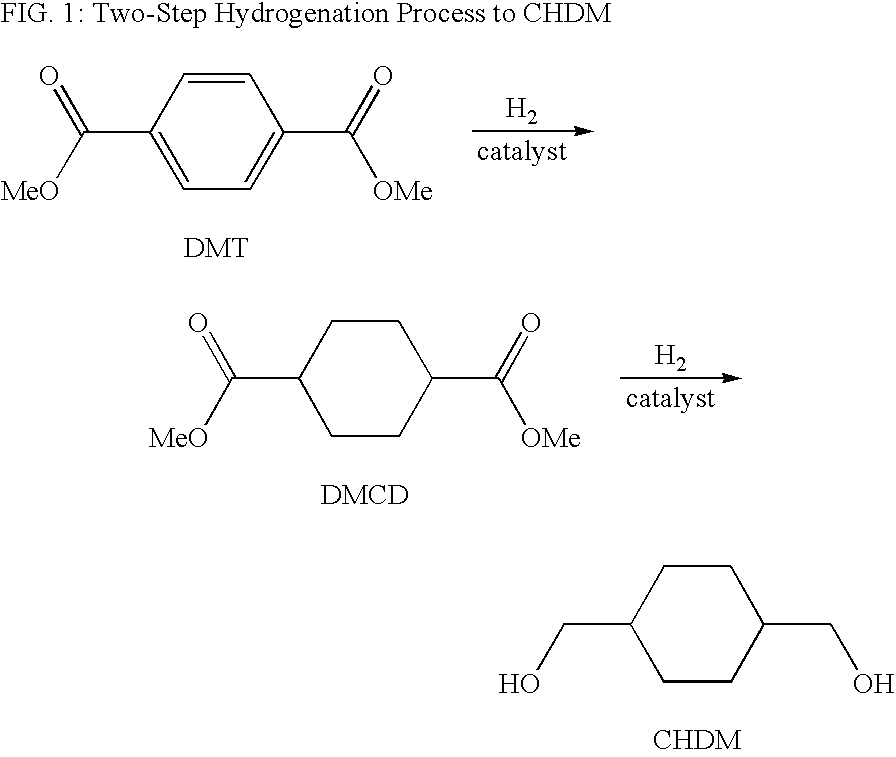Process for a cyclohexanedimethanol using raney metal catalysts
- Summary
- Abstract
- Description
- Claims
- Application Information
AI Technical Summary
Benefits of technology
Problems solved by technology
Method used
Image
Examples
examples
[0033]General—The experiments were carried out in a continuous mode of operation utilizing a vertical trickle bed reactor having a length of 72 inches and an inside diameter of 1 inch as the reactor. The reactor temperature was measured with a series of 10 thermocouples inserted into the wall of the reactor. The reactor was loaded with 500 mL of a shaped, activated, fixed-bed catalyst. Raney nickel catalysts (Metalyst® Alpha 9401) were obtained from Degussa Corporation. The catalyst was supported by 20 mL of Penn State packing and 104 mL glass beads. An additional 400 mL of glass beads were placed on top of the catalyst.
[0034]The feed reservoir was a jacketed, 4L graduated vessel with a bottom take-off valve. The DMCD used in the experiments consisted of approximately 67% cis isomer ad 33% trans isomer assayed 99.5% (area %) by gas chromatography. Molten DMCD was pumped through a high-pressure diaphragm pump into a recycle stream and then through a preheater to raise the feed temper...
examples 1-6
[0037]Using the general procedure described above, DMCD was hydrogenated using an activated (pre-reduced) Raney nickel catalyst doped with 3 wt % rhenium (Metalyste Alpha® 9401, available from Degussa Corporation) at temperatures ranging from 200 to 215° C., reactor pressures ranging from 172 to 345 barg (2500 to 5000 psig) and a liquid hourly space velocity, “LHSV” (defined as the volume in litres of DMCD fed to the reactor per litre of catalyst per hour) of 1 to 3 litres DMCD / litre catalyst per hour. The results are shown in Table 1. Percent conversions were calculated as the molar fraction of DMCD converted to CHDM, intermediates, and by-products per mole fed to the reactor. The cis:trans ratio is given as the molar ratio of cis CHDM to trans CHDM.
[0038]
TABLE 1PressureLHSV%cis:transExampleTemperature (° C.)(barg)(L / Lcat-hr)ConvRatio1205345322.90.72215345324.10.53225345322.70.442003451.528.60.75215172124.80.46200345135.40.6
examples 7-9
[0039]Using an activated (pre-reduced) Raney nickel catalyst doped with 3 wt % rhenium (Metalyst® Alpha 9401, available from Degussa Corporation) and the general procedure described above, DMCD was hydrogenated to CHDM at 345 barg (5000 psig), a feed rate of 1500 mL / hr, and at temperatures of 205° C., 215° C., and 225°. The results of the analysis of the reactor effluent are shown in Table 2 and are given in GC area %. Monoester is methyl 1-hydroxymethyl-4-cyclohexanecarboxylate a product of the partial hydrogenation of DMCD. The term “Imp” refers to the area percentage of unknown impurities.
[0040]
TABLE 2DMCD Hydrogenation Using Raney Nickel Doped with 3-wt % RePressure: 345 bargFeed Rate: 1500 mL / hourTempMono-transcis%cis / transExample(° C.)DMCDesterCHDMCHDMMeOHWaterImp.ConvRatio720563.819.64.73.22.75.01.135.70.7821562.020.05.72.81.65.72.238.30.5922560.618.25.32.30.77.15.940.20.4
PUM
| Property | Measurement | Unit |
|---|---|---|
| Temperature | aaaaa | aaaaa |
| Temperature | aaaaa | aaaaa |
| Temperature | aaaaa | aaaaa |
Abstract
Description
Claims
Application Information
 Login to View More
Login to View More - R&D
- Intellectual Property
- Life Sciences
- Materials
- Tech Scout
- Unparalleled Data Quality
- Higher Quality Content
- 60% Fewer Hallucinations
Browse by: Latest US Patents, China's latest patents, Technical Efficacy Thesaurus, Application Domain, Technology Topic, Popular Technical Reports.
© 2025 PatSnap. All rights reserved.Legal|Privacy policy|Modern Slavery Act Transparency Statement|Sitemap|About US| Contact US: help@patsnap.com

